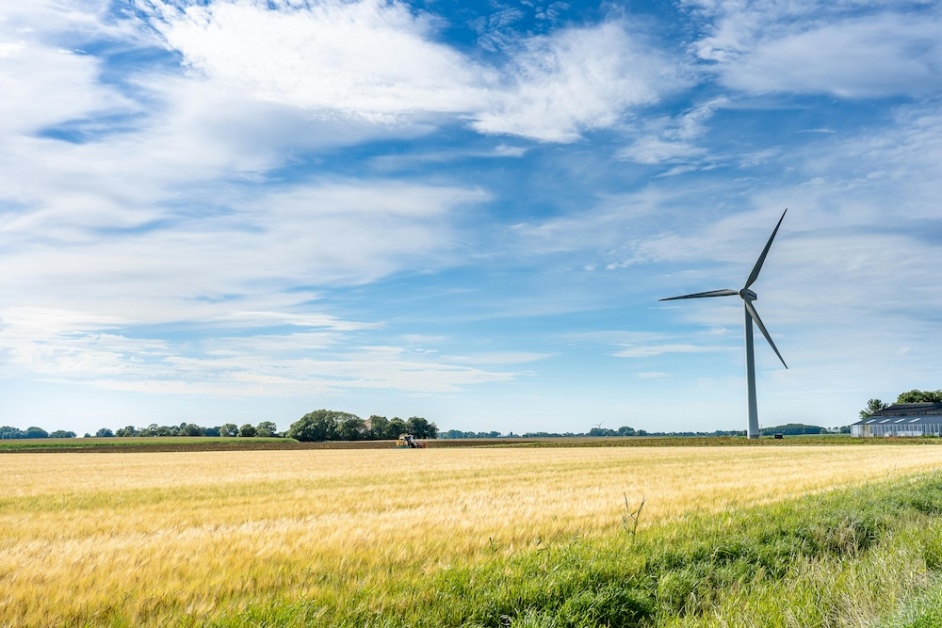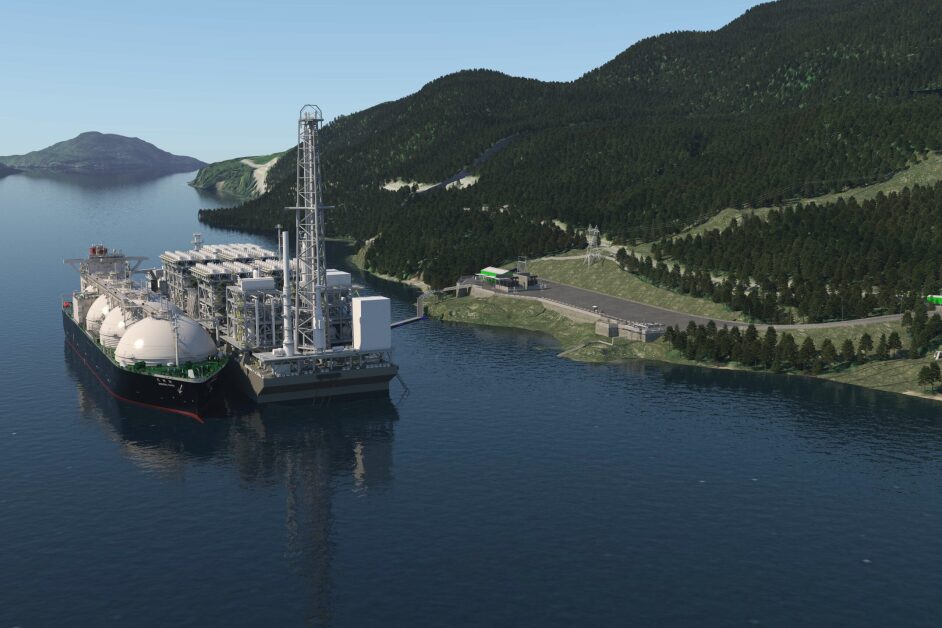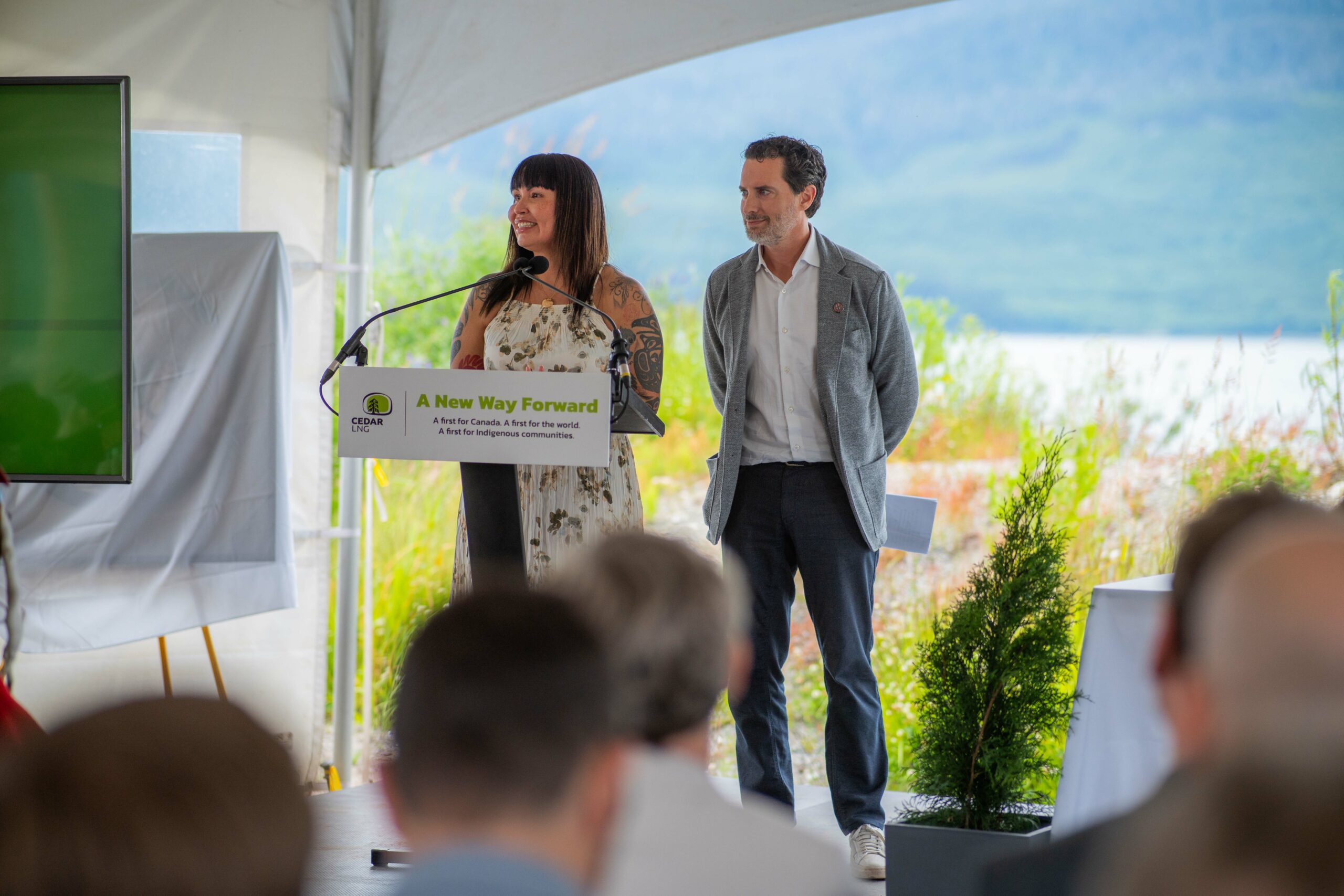Crystal Smith, Chief Councillor of the Haisla Nation and Scott Burrows, president and CEO of Pembina Pipeline, announce the final investment decision to proceed with Cedar LNG, the world’s first Indigenous majority-owned LNG project, in June 2024. (source)
On Monday, September 30, the streets of every city and hallways of every school will be filled with Canadians wearing orange shirts in recognition of the annual National Day for Truth and Reconciliation.
As our country strives to create an inclusive future, it’s important to recognize that reconciliation has a place in every industry in Canada — and energy is no exception.
Meaningful reconciliation recognizes Indigenous rights and engages Indigenous peoples as partners in energy transformation.
This shift not only honours Indigenous people’s sovereignty but also leverages their unique knowledge, leading to innovative and sustainable energy solutions that benefit all Canadians.
By examining the current landscape of Indigenous equity in energy projects, we can appreciate the transformative potential of these partnerships.
In November 2023, the Indigenous Law Bulletin estimated that more than half of Canada’s energy projects (52 per cent) have a minority Indigenous equity interest.
However, the report also estimates that “the number of reported projects with equal or majority Indigenous equity ownership will become more common than those with a minority Indigenous equity interest” in the coming years.
As more Indigenous communities increasingly step into natural resource and energy projects, Canada is witnessing how Indigenous ownership, collaboration and stewardship drives economic reconciliation and fosters the ongoing pursuit of affordable, reliable energy for all.
“The work that the energy community [in Canada] is doing is more far-reaching than any other oil-producing country, and that’s something we should be proud of,” says Gurpreet Lail, president and CEO of Enserva, adding that Canada’s leadership could serve as a template for other countries when it comes to economic reconciliation and Indigenous equity in the energy industry.
“We are finally at the stage where there’s authentic, economic partnerships being made, and I think that’s an important message to have across all conversations.”

Renewable energy and Indigenous ownership: Cowessess First Nation
Cowessess First Nation, a member of the Saulteaux First Nations in southern Saskatchewan, has become an established leader in renewable project development.
The Awasis Solar Project, created in partnership with Elemental Energy, is 95 per cent owned by the Cowessess First Nation and began operations in 2022. The project has a 35-year life expectancy.
The Bekevar Wind Energy Project, created in partnership with Innagreen, Renewable Energy Systems Canada and Cowessess-owned entity Awasis Nehiyawewini Energy Development, is expected to complete construction by the end of this year.
The project will supply 200 megawatts of zero-emissions power through 36 wind turbines, while generating revenue that can be reinvested into the community’s continued growth.
“Cowessess takes pride in being leaders in the renewable energy space in Saskatchewan,” Rebecca Acikahte, business development manager for Cowessess Ventures, told CTV News. “And, it’s a way for the nation to generate some revenue to put into social projects and build up the community.”

Cedar LNG rendering 1: Artist’s Rendering – View looking south from above Douglas Channel towards the proposed facility and docked LNG carrier.
The world’s first Indigenous majority-owned LNG project: Cedar LNG
Cedar LNG is a floating LNG facility in Kitimat, British Columbia, within the traditional territory of the Haisla Nation that is now under construction.
With 50.1 per cent ownership belonging to the Haisla Nation, Cedar LNG marks an unprecedented milestone: it is the first Indigenous-majority owned LNG project in the world.
A positive final investment decision for this innovative project was announced on June 25, 2024. Construction is underway, and the facility is slated to be in service in late 2028.
“Because of our Nation’s determination and environmental leadership, Cedar LNG will make the most significant mark on economic reconciliation ever in our country,” Crystal Smith, Chief Councillor of the Haisla Nation, said in a statement.
“With Cedar LNG, we have proven that Indigenous communities can successfully forge a path to economic independence and generational prosperity. We have created a model for how sustainable energy development should be done, with Indigenous Nations as owners.”
Powered by renewable electricity from BC Hydro, Cedar LNG will produce industry-leading, cost-competitive Canadian LNG for international export.
According to our research, 77 per cent of engaged women support LNG exports to provide energy security and a successful Canadian economy — two things Cedar LNG is expected to consistently contribute to when it comes online in 2028.
The benefits don’t stop there.
The project will employ as many as 500 people during peak construction and provide 100 full-time positions during operation, further bolstering the economic prosperity and self-sufficiency of the Haisla Nation and the surrounding region.
Empowering economic prosperity: The Indigenous Loan Guarantee Program
Cedar LNG and the renewable energy projects being implemented by the Cowessess First Nation are just a few examples of how Indigenous communities are contributing to the diverse energy mix we know engaged women support.
With so many opportunities for Indigenous partnerships and equity, the federal government announced the proposed launch of the Indigenous Loan Guarantee Program in Budget 2024.
The federal program aligns with several already in place at the provincial level, such as loan guarantees from the Alberta Indigenous Opportunities Corporation, the Saskatchewan Indigenous Investment Finance Corporation and the implementation of the First Nations Equity Financing Framework in British Columbia.
Designed to unlock access to capital for Indigenous communities, the federal program is committed to helping remove historical barriers to equity investment in natural resource and energy projects.
According to the Canada Development Investment Corporation (CDEV), the department responsible for the delivery of the program, the objective is to “advance Indigenous participation in major projects through the Indigenous Loan Guarantee Program by providing more opportunities for Indigenous communities to benefit from the significant number of natural resource and energy projects proposed to take place on their territories.”
The announcement of the program received public endorsements from major Canadian energy companies such as Enbridge, the Canadian Renewable Energy Association and more, who celebrated the program’s recognition of the importance of Indigenous involvement in Canada’s energy resource economy.
The program was also welcomed by the countless Indigenous communities, governments and organizations across Canada who are playing an increasingly critical role in these developments.
“It empowers self-determinations for Indigenous nations, to decide what project is right for them,” said Niilo Edwards, First Nations Major Projects Coalition CEO.
As Indigenous leadership continues to grow in Canada’s energy sector, it not only fosters economic prosperity but also strengthens community self-determination and environmental stewardship.
By embracing equitable partnerships, Indigenous nations are shaping a more resilient, inclusive and sustainable energy future — one that benefits all Canadians while honouring the deep connection between Indigenous peoples and their land.
This transformative involvement in the energy industry is a key driver of reconciliation, empowering future generations to thrive.
